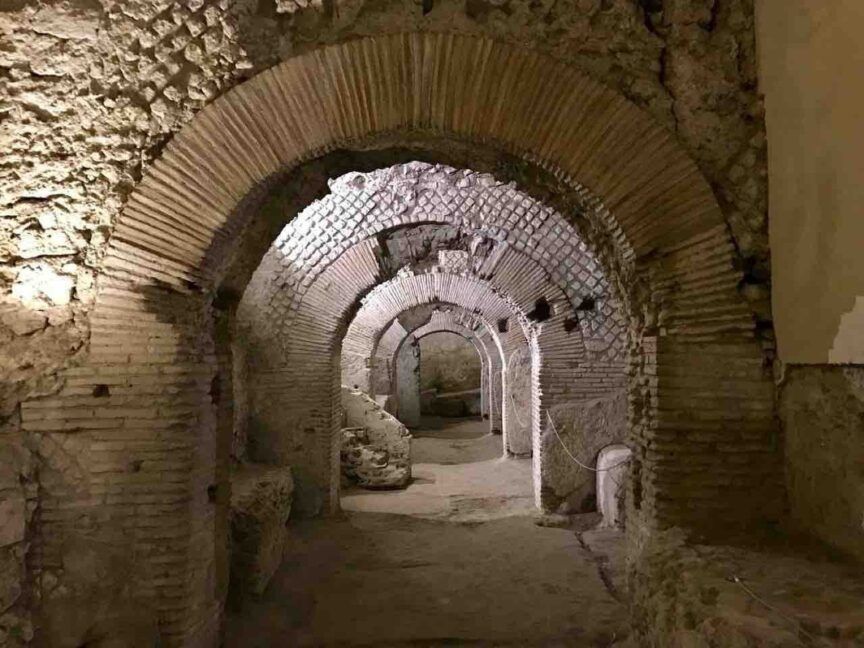Napoli sotterranea. Mistero e bellezza.
Sotto la città antica di Napoli si trova una vasta zona geotermica composta da tufo, una roccia vulcanica. Negli ultimi due millenni e mezzo, ampie grotte e gallerie sono state scavate nel tufo, formando una città ombra oscurata sotto terra. La rete sotterranea di 280 miglia (450 chilometri) è stata formata dai greci nel IV secolo a.C. per costruire quella che allora si chiamava Neapolis, o “Città Nuova”. In seguito i Romani utilizzarono le camere e i percorsi per costruire gli acquedotti che fornirono acqua a molti secoli di napoletani. Con il passare dei secoli, gli edifici sono stati costruiti sopra le precedenti infrastrutture antiche, e i resti di queste strutture sono stati nascosti in profondità sotto la città. Oggi, Napoli Sotterranea offre la possibilità di esplorare questa città italiana da un punto di vista diverso. In una lunga cassa che scende a 40 metri sotto terra, nelle cavità tufacee si trovano acquedotti, gallerie fognarie, cisterne per l’acqua piovana, caverne, catacombe e ipogei precristiani, oltre a gallerie stradali e ferroviarie. Alcune grotte che facevano parte del serbatoio sono ancora oggi piene d’acqua. Uno dei punti salienti della rete sotterranea sono i resti del teatro greco-romano di Neapolis, dove l’imperatore romano Nerone aveva anche il suo camerino privato. Molti anni dopo, la rete sotterranea fu utilizzata come rifugio antiaereo durante la Seconda Guerra Mondiale, e si possono ancora vedere nelle gallerie i reperti bellici dimenticati, come armi e veicoli. Più recentemente si trovano i primi Giardini dell’Ipogeo al mondo, un esperimento per far crescere varie specie di piante lontano dall’inquinamento, ma anche dalla luce, nelle camere oscure sotto la città.
Naples underground. Mystery and beauty.
Below the ancient city of Naples is a vast geothermal zone composed of tufa, a volcanic rock. Over the last two and a half millennia, large caves and tunnels have been dug into the tuff, forming a shadow city darkened underground. The underground network of 280 miles (450 kilometers) was formed by the Greeks in the 4th century BC to build what was then called Neapolis, or “New City”. The Romans later used the chambers and pathways to build the aqueducts that supplied water to many centuries of Neapolitans. As the centuries passed, the buildings were built over the previous ancient infrastructure, and the remains of these structures were hidden deep beneath the city. Today, Naples Underground offers the opportunity to explore this Italian city from a different point of view. In a long box that descends to 40 meters below ground level, in the tufa cavities are aqueducts, sewer tunnels, rainwater tanks, caves, catacombs and pre-Christian hypogea, as well as road and rail tunnels. Some caves that were part of the reservoir are still full of water today. One of the highlights of the underground network are the remains of the Greek-Roman theatre in Neapolis, where the Roman Emperor Nero also had his private dressing room. Many years later, the underground network was used as an air-raid shelter during World War II, and you can still see forgotten war relics such as weapons and vehicles in the tunnels. More recently, the first Hypogeum Gardens in the world can be found, an experiment to grow various species of plants far from pollution, but also from light, in the dark chambers under the city.
|
|
Con Amazon Kindle Unlimited hai letture illimitate da qualsiasi dispositivo: IOS, Android, PC. Scegli tra più di un milione di titoli e leggi dove e quando vuoi con l’app di lettura Kindle.
In promozione per 2 mesi GRATIS!
Poi rinnovi a 9,99€ al mese oppure puoi annullare l’iscrizione in qualsiasi momento.

